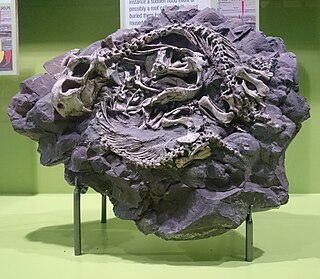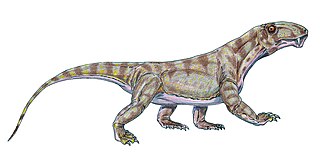
Therapsida is a major group of eupelycosaurian synapsids that includes mammals and their ancestors. Many of the traits today seen as unique to mammals had their origin within early therapsids, including limbs that were oriented more underneath the body, as opposed to the sprawling posture of many reptiles and salamanders.

Placerias is an extinct genus of dicynodonts that lived during the late Carnian age of the Triassic Period. Placerias belongs to a group of dicynodonts called Kannemeyeriiformes, which was the last known group of dicynodonts before the taxon became extinct at the end of the Triassic.

Diictodon is an extinct genus of pylaecephalid dicynodont. These mammal-like synapsids lived during the Late Permian period, approximately 255 million years ago. Fossils have been found in the Cistecephalus Assemblage Zone of the Madumabisa Mudstone of the Luangwa Basin in Zambia and the Tropidostoma Assemblage Zone of the Teekloof Formation, Tapinocephalus Assemblage Zone of the Abrahamskraal Formation, Dicynodon Assemblage Zone of the Balfour Formation, Cistecephalus Assemblage Zone of the Middleton or Balfour Formation of South Africa and the Guodikeng Formation of China. Roughly half of all Permian vertebrate specimens found in South Africa are those of Diictodon. This small herbivorous animal was one of the most successful synapsids in the Permian period.

Galechirus is an extinct genus of anomodont therapsids. It was about 30 cm (1 ft) long.

Clelandina is an extinct genus of rubidgeine gorgonopsian from the Late Permian of Cistecephalus Assemblage Zone of South Africa. It was first named by Broom in 1948. The type and only species is C. rubidgei. It is relatively rare, with only four known specimens.

Galepus is an extinct genus of anomodont therapsids.
Cistecephaloides is an extinct genus of dicynodont therapsids of the Cistecephalus Assemblage Zone, Beaufort Group of South Africa.
Hexacynodon is an extinct genus of therocephalian therapsids. Fossils have been found in the Archosaurus rossicus Assemblage Zone of Russia.
Knoxosaurus is an extinct genus of non-mammalian synapsids containing the species Knoxosaurus niteckii that existed approximately 279.5 to 268 million years ago. It was named by American paleontologist Everett C. Olson in 1962 on the basis of fragmentary fossils from Middle Permian-age deposits in the San Angelo Formation of Texas in the United States. Olson placed Knoxosaurus in a new infraorder called Eotheriodontia, which he considered a transitional group between the more reptile-like "pelycosaurs" and the more mammal-like therapsids. Knoxosaurus and Olson's other eotheriodonts were later considered to be undiagnostic remains of basal synapsids, no more closely related to therapsids than are other pelycosaur-grade synapsids.
Rhinodicynodon is an extinct genus of non-mammalian synapsid of the Middle Triassic (Anisian) Donguz Formation of European Russia.
Xenocretosuchus is an extinct genus of tritylodont therapsids from the Aptian Ilek Formation of Siberia, in the Russian Federation. The type species, X. sibiricus, is known only from dental elements, as is X. kolossovi, described from the Batylykh Formation in 2008. Both species may be part of the genus Stereognathus.
Kunminia is a genus of cynodont synapsids from the Early Jurassic (Sinemurian) Lufeng Formation of China.

Regisauridae is an extinct family of small carnivorous theriodonts from the Late Permian and Early Triassic of South Africa and China.

Inostranceviinae is an extinct subfamily of gorgonopsid therapsids that lived during the Late Permian. Only two genera are known, both from Russia.
Wantulignathus is genus of biarmosuchian therapsid from the Madumabisa Mudstone Formation, Zambia.

Biarmosuchidae is a family of biarmosuchian therapsids from Russia.
Biarmosuchoides is a genus of biarmosuchian therapsid found in Dubovka I in Russia. It is known only from SGU 104B/2051, a left dentary.

Ericiolacertidae is a family of therocephalian therapsids. The family living in the earliest Triassic after the Permian-Triassic extinction event. Genera are: Ericiolacerta found in the Fremouw Formation of Antarctica and the Normandien Formation of South Africa, Pedaeosaurus found in the Fremouw Formation of Antarctica and Silphedosuchus, from the Petropavlovka Formation of Russia, east of the Urals. The family is composed of carnivores.
Ictidosaurus was a therapsid genus found in the Abrahamskraal Formation of South Africa, which lived during the middle Permian period. Fossils of the type species were found in the Tapinocephalus, and the base of the Eodicynodon assembly zones, of the Karoo Basin. Older classifications of the species, along with many other specimens found in the Iziko South African Museum archives, were originally classified within therocephalian family names, in this case the Ictidosauridae, which has been reclassified as belonging to the Scylacosauridae. The type species is I. angusticeps.














